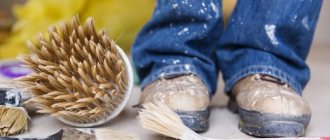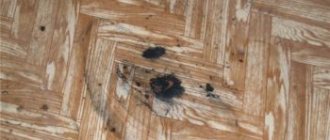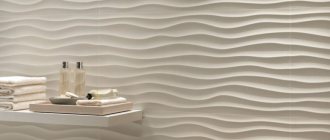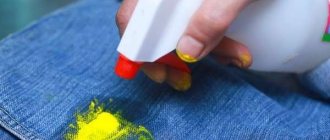Oil paint is a paint and varnish product that is made using vegetable oils or drying oil.
It surrounds a person everywhere: on the street and indoors. You can get dirty with it anywhere: sitting on a bench in the park, holding the railing, touching the horizontal bar on the playground and more.
Knowing how to properly wash the oil composition from different surfaces, you can quickly deal with the problem if it arises. Read the article about how to remove oil paint from skin, clothes, ceilings and other surfaces.
Why remove old paint?
Before you understand how to remove oil paint, you should understand in which cases this step cannot be avoided. When deciding whether to leave a layer or not, it is important which repair option is going to be done after.
If you mean leveling the surface with a layer of plaster, followed by puttying, gluing wallpaper, painting or installing tile material, then you cannot do without removing oil paint. The material is smooth and has poor adhesion to other materials. If you leave the old finish, you may find that the new one quickly falls off, and you will have to carry out repairs twice. If they install the materials using the frame method, then it will be possible to leave the wall with a layer of old paint.
Also, the choice of finishing material affects the determination of the method of dismantling paint.
The material is smooth and has poor adhesion to other materials.
Top 3 universal recipes
There are universal products that can be used in any situation, regardless of where exactly the oil paint ended up.
Laundry soap
The product contains acids, alkalis and fats. These three components are excellent at breaking down oil compounds.
Mode of application:
- Moisten the item that has the stain.
- Lather the soap.
- Apply it to the contaminated area.
- If the paint has dried, then leave the foam for 5-10 minutes to act.
- Rub the contaminated surface.
- Rinse off the composition with water.
Soap can be safely used on human skin; it can be used to wash various fabrics and clean wooden and plastic surfaces.
Petrol
This petroleum product has the property of destroying paint molecules. Use it as follows:
- apply the composition to a cloth or cotton pad;
- wipe the stain;
- remove gasoline residues with paper napkins;
- wash the treated surface with water.
Butter combined with washing powder
The oil breaks down the paint molecules, and the detergent allows you to wash out the fatty component and pigment.
Mode of application:
Prepare a paste based on oil and powder.- Apply it to the stain.
- Leave for 10-30 minutes.
- Remove the composition with a paper napkin.
- Clean off any remaining paint with a brush.
- Rinse the treated area with hot water.
The sooner treatment begins, the easier it is to deal with the paint.
Classification of possible methods
When choosing what to use to remove oil paint, take into account the budget allocated for repairs and working conditions. Mechanical, thermal or chemical methods are usually used.
Which option will be effective is decided taking into account the type of base. Wood, metal, plastic, glass, brick or other. After all, sometimes when painting, paint can get onto other surfaces. And then you need to erase traces from them. The process is also influenced by the constituent elements included in the paint and the state of the layer at the time of the decision to erase it.
If a mechanical method is used to scrub off the paint and varnish material, then you will need to apply putty to cover the resulting defects and obtain a smooth base. For heat treatment, you must have a hair dryer or a blowtorch. To select chemicals, you need accurate knowledge of the type of base.
How long the paint will be scrubbed off the wall also depends on the method. The mechanical method is the most difficult in terms of physical effort. This option is not suitable for working with a wooden base; it is too easy to damage the base.
The thermal method gives a good result, but it is also not used with wood. The use of chemicals is a more convenient option, but also has a number of subtleties. And it is necessary to follow safety precautions in order to avoid health problems due to the toxicity of many compounds.
If a mechanical method is used to scrub off the paintwork material, then putty will then need to be applied to cover the resulting defects.
Important Tips
When removing oil paints, you should adhere to the following recommendations:
Consider the type of surface. The method of removing the coloring composition will depend on this.- Protect respiratory organs, skin of hands and mucous membranes when working with chemical compounds.
- Ventilate the room if the cleaning product has a pungent odor.
- Before using the new composition for the first time, test it on a small area.
- Before removing paint, remove dust and other contaminants from the surface.
When working with removers and caustic substances, it is advisable to use glass containers. Not all materials can withstand the effects of chemicals.
In the future, such containers must be disposed of. Food cannot be stored in them.
Washing with special solutions
It is convenient to wash off a layer of paint with chemicals; it does not create a lot of dirt and dust, there are no loud sounds during work, which is often uncomfortable when you live in an apartment building. But the process may take longer than when choosing other options. The layer will be washed off when they wait a certain amount of time required for impregnation and the substance begins to act on the paint.
At home, you can choose alkaline or organic types of reagents. Alkali-based solutions are highly toxic.
The technician must wear a respirator, protective gloves on his hands, and avoid contact of the substance with the skin.
Using this option, plants are removed from the room and pets are taken out. Also, people who are not involved in the work and are not protected from toxic elements should not be present in the room. A good level of ventilation is created, and the temperature is monitored, which should not be lower than +15 degrees.
Different types of paints can be washed with chemical compounds; the technique is distinguished by its versatility. You regularly have to resort to this method, because others may not be able to cope with the task.
It is imperative to follow the manufacturer's instructions for the reagent in order to properly clean the base.
Products can be applied with a brush; brushes must be of a rigid structure; rollers and hard, porous sponges can be used. After treating the entire surface, wait for the time required on the label to obtain the desired reaction. The paint layer becomes soft under the influence of substances, and it can be cleaned with a spatula or scraper. After completing the work, it is recommended to thoroughly wash the tools to remove any substances to ensure their safe storage.
It is convenient to wash off a layer of paint with chemicals; it does not create a lot of dirt and dust, and there are no loud sounds during operation.
Sunflower oil
Regular sunflower oil also does a good job of removing paint. First, rub the stain with a damp cloth; if it is old and dry, then lightly scratch it with a sharp knife or spatula. Then pour a little sunflower oil onto the paint-stained area and leave for a while (at least 2-3 hours). When the time is up, wipe the floor twice, first with soapy water and then with clean water.
Thermal effects: hair dryer, iron
This option is used as standard to clean wooden substrates. It is required to heat the paint surface using a hair dryer or a blowtorch; heat it in zones. The temperature effect involves bringing the base to 120-150 degrees. If bubbles appear on the layer, you can turn off the device. You need to clean the layer with a spatula.
But there are some prohibitions when using the method:
- Do not heat the surface in areas where electrical wiring passes; the wires may melt from such an action;
- Also, working near electrical fittings is prohibited.
In order not to overheat the layer, you need to monitor the degree of heating, otherwise you can stick the heated paint to the base, and then it will not be able to wipe off. When working, the paint will release toxic substances, so create ventilation in the room and wear a respirator.
This option is used as standard to clean wooden substrates.
Chemicals
If folk remedies cannot clean the damaged area of clothing, you can use chemicals. They can be found in any online store. But here there are a number of features that need to be taken into account when purchasing.
- color . If the clothes are colored, then there is no need to try to remove stains using a product intended for white fabrics. It is likely that it will damage the pigment.
- The temperature at which a chemical begins to work. Some stain removers require washing in hot water after cleaning, however, not every fabric can withstand this test.
- The presence of chlorine in the composition. If it is, then the product is suitable for washing only white clothes.
To ensure that not a trace remains of the stain, you need to:
- Apply the selected stain remover to the damaged area.
- Rub the dirty item without rubbing too much. Especially if it is a delicate fabric.
- Leave everything until the applied product is completely absorbed and takes effect. The specific time can be found on the stain remover label.
- Wash the item in the washing machine. To make the right choice and then not be upset about a damaged item, you can turn to reviews. They can be easily found on the Internet. Here, many point out both the advantages and disadvantages of stain removers. After reading them, you can quickly decide on the purchase of the product.
Stain remover
Grinder and drill - mechanics for quick results
You can quickly remove a layer of oil paint with power tools; also, only this option can be used if the base is concrete. By removing paint from the walls of a bathroom or other room in this way, you don’t have to worry about the appearance of toxic elements, but a lot of dust will be generated and there will be a lot of cleaning up after work.
The master ensures his safety with a respirator and safety glasses. Most often they use a drill or grinder, proceed in the following way:
- An abrasive wheel is used with a grinder attachment; a metal brush is also suitable. To reduce dust, there are options with a built-in vacuum cleaner, or take a separate vacuum cleaner and suck in the dust in parallel. You can pre-wet the wall;
- It will be possible to install a bit on the drill for a brick surface;
- You can also choose a paint remover chain for the drill. You can replace the attachment with a chain with 5 mm links. Links are taken in odd numbers. Then, having secured the chain on the tool, the remaining links are distributed evenly on the sides. As links are destroyed during the cleaning process, the opposite link is also removed. A minimum of three links can remain on each side.
For right-handers, set the direction of rotation to the left, for left-handers to the right, when choosing a chain for work.
You can quickly remove a layer of oil paint with power tools; also, only this option can be used if the base is concrete.
How to remove oil paint from clothes at home using special means
Today there is a wide range of products for removing dyes from clothes of various compositions. Such solvents can be purchased at hardware stores. They will help you remove oil paint from clothes quickly and easily. But do not neglect the instructions, read them and strictly follow the rules. Only then will you be able to remove the paint without ruining the item.
Mechanical restoration
When figuring out how to remove old paint from wooden surfaces, they often choose the simplest method. It comes down to mechanical removal of the paint layer. There are several ways to do this. First you should evaluate the structure of the material. If the wood is soft, then abrasive particles from tools will destroy the product.
When using any mechanical method, do not press hard on the tool.
Processing the product with sandpaper
Sandpaper allows you to quickly erase the old coating. But suitable for a thin layer. Repeated staining of sandpaper will not completely remove it. Also not suitable for difficult places on the product.
The technology for using sandpaper consists of the following steps:
- Prepare the sandpaper. You will need several sheets of different grain sizes.
- Begin by processing with coarse sandpaper. This will remove the top layer.
- Change the coarse grain to a finer one and use this sandpaper to clean the wood. The treatment is carried out until the surface becomes smooth.
To make the process easier, it is recommended to take a piece of timber and wrap it with sandpaper. It’s more convenient to work this way. The advantage of this method is the low probability of damage to the product and the availability of tools.
To make the process easier, it is recommended to take a piece of timber and wrap it with sandpaper.
Cleaning the product with an angle grinder (angle grinder)
The grinder cannot be turned on at full power when used in this case. It can damage the wood. To quickly get rid of the old paint layer, it is recommended to use a petal nozzle. The workflow is simple. You need to take a stable position, grasp the tool with both hands so that it does not slip out, and begin to process the surface. Paint particles quickly clog the discs of the machine. Therefore it is necessary to change them regularly. When the last layer of paint appears, it must be removed manually. To do this, use sandpaper. The resulting dust can be wiped off with a cloth previously moistened with water.
The grinder cannot be turned on at full power when used in this case.
Using a drill
The drill must be kept perpendicular to the wood when processing. The movements are not abrupt, smooth and accurate. Efforts need to be applied slowly and gradually. Paint particles may fly in different directions. Therefore, when choosing this method, be sure to use safety glasses. To avoid damaging the product, it is recommended to use special grinding attachments.
The drill must be kept perpendicular to the wood when processing.
Hard paint brushes
When using a hard brush, the product being treated must be taken outside. If this is not possible, all surrounding objects and surfaces are wrapped and covered with polyethylene.
This method consists of the following steps:
- An ax is used to make notches on the product. The wood is moistened with water and left for a couple of minutes so that the liquid is absorbed.
- The surface is treated with a metal brush, removing the top painted layer. To increase the effect of the process, it is recommended to hold the tool at an angle to the product.
- The bottom paint layer is removed with sandpaper.
This method is often used to process doors and window frames.
When using a hard brush, the product being treated must be taken outside.
Kerosene
Fresh traces of paint can also be removed using kerosene. Lightly heat the liquid and wet a clean cleaning cloth with it. After this, place a “compress” on the stain and let it sit for a while. Periodically check for traces of contamination; if the paint has softened, rub the area with a sponge with baking soda or powder, and then rinse with clean water.











